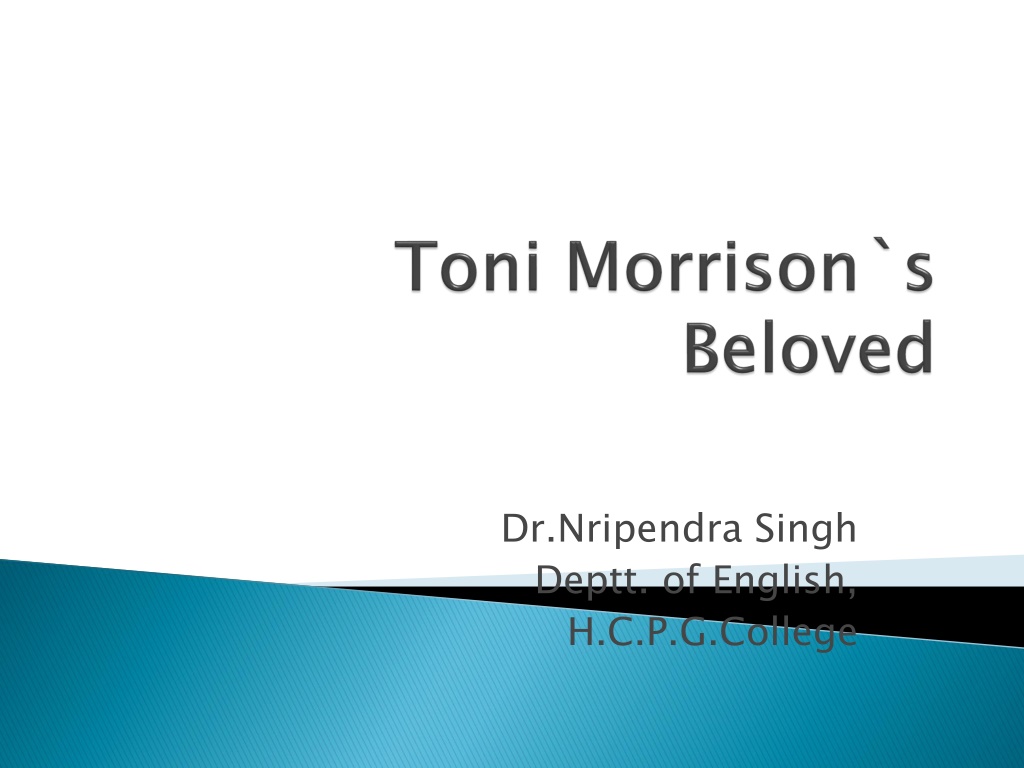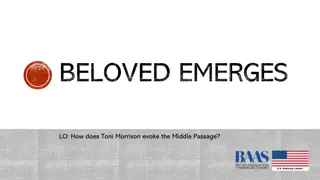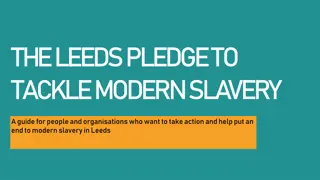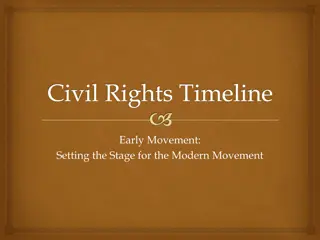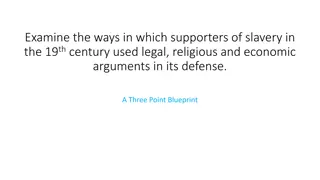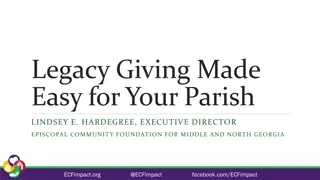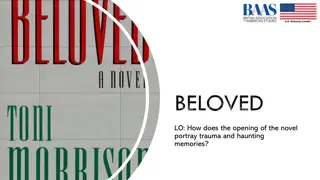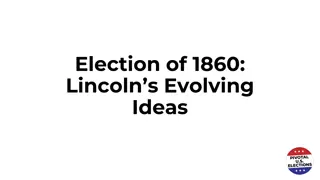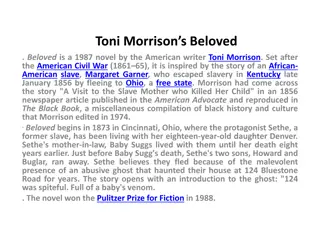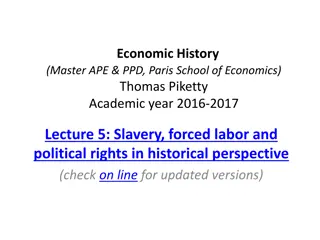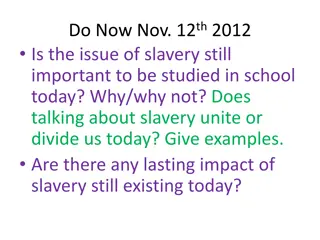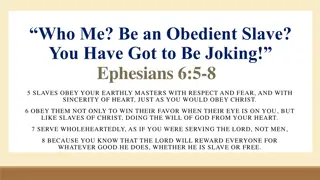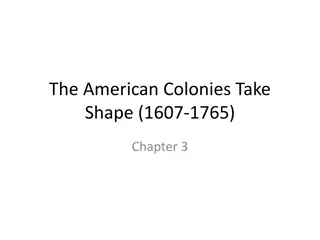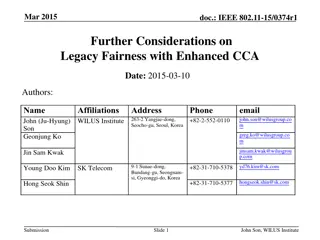Understanding Toni Morrison's Beloved: An Exploration of Slavery's Legacy
Beloved, a novel by Toni Morrison, delves into the repercussions of slavery through the haunting tale of Sethe, a former slave who grapples with her past and motherhood. Set in post-Civil War America, the story intertwines themes of love, family, and self-possession in a poignant narrative that questions the meaning of freedom and ownership in the shadow of slavery's brutal history.
Download Presentation

Please find below an Image/Link to download the presentation.
The content on the website is provided AS IS for your information and personal use only. It may not be sold, licensed, or shared on other websites without obtaining consent from the author. Download presentation by click this link. If you encounter any issues during the download, it is possible that the publisher has removed the file from their server.
E N D
Presentation Transcript
Dr.Nripendra Singh Deptt. of English, H.C.P.G.College
Belovedis Toni Morrison's fifth novel. Published in 1987 as Morrison was enjoying increasing popularity and success, Beloved became a best seller and received the 1988 Pulitzer Prize for fiction. Its reception by critics was overwhelming, and the book is widely considered Morrison's greatest novel to date. Mythic in scope, Belovedis an attempt to grapple with the legacy of slavery. Morrison based her novel on a real-life incident, In which an escaped slave woman who faced recapture killed her children rather than allow them to be taken back into slavery. In the novel, the protagonist's near-recapture follows the Fugitive Slave Act of 1850, part of the Compromise of 1850, which stated that escaped slaves, as property, could be tracked down across state lines and retrieved by their old masters. In Beloved, Morrison explores themes of love, family, and self-possession in a world where slavery has only recently become a thing of the past. Beloved is the ghost of Sethe's murdered child, returned for unclear reasons, embodied as a full-grown woman at the age that the baby would have been had it lived. Part history, part ghost story, part historical fiction, the novel also seek to understand the impact of slavery, both on the psychology of individuals and on the larger patterns of culture and history. Morrison was drawn to the historical account, which brought up questions of what it meant to love and to be a mother in a place and time where life was often devalued. The novel powerfully portrays the meanings of what it means to be owned by another and the difficulty of owning oneself.
In 1873, Sethe and her daughter Denver live in 124, a house in a rural area close to Cincinatti. They are ostracized from the community for Sethe's past and her pride. Eighteen years have passed since she escaped from slavery at a farm called Sweet Home. Sweet Home was run by a cruel man known as schoolteacher, who allowed his nephews to brutalize Sethe while he took notes for his scientific studies of blacks. Sethe fled, although she was pregnant, delivering the child along the way with help from a white woman named Amy. Sethe's husband, who was supposed to accompany her, disappeared. After her escape to Cincinatti with her four children, Sethe enjoyed only twenty-eight days of freedom before she was tracked down by her old master. Rather than allow her children to be returned to slavery, she attempted to kill all of them, succeeding only in killing the baby girl. Rejected then by her master, who saw she was no longer fit to serve, Sethe was also saved from hanging and was released to raise her remaining three children at 124. The ghost of the dead baby began to haunt the house.
The two sons, Howard and Buglar, left after having particularly frightening encounters with the ghost. The grandmother, Baby Suggs, died a broken woman. Baby Suggs had been a great positive force in Cincinatti's black community, regarded by many as an inspiring holy woman. After what happened to Sethe, she gave up her preaching and retired to bed, asking only for scraps of color. Years after her death, Denver and Sethe continue to live in the house alone. Sethe works as a cook, and Denver spends her days alone. Denver is terribly lonely but is also afraid to leave the yard even though she is eighteen years old. In 1873, two visitors come to 124. The first is Paul D a man who was a slave with Sethe back at Sweet Home. Paul D, like Sethe, is haunted by the pain of the past. He witnessed and suffered unspeakable atrocities before the end of t he Civil War brought him his freedom, and he has survived by not allowing himself to have strong feelings for anything or anyone. He has particularly dark memories of time spent in a prison for blacks, where he worked in a chain gang by day and was kept in a box in the ground at night.
The second visitor is a girl named Beloved. It gradually becomes clear that she is the ghost of the dead baby come back to life, at the age that the baby would have been had it lived. Awkward, unable to speak like an adult, and dressed in strange clothes, Beloved seems vulnerable at first but proves to be powerful and malicious. Her purposes initially seem benign and are never fully understood, but by the end of the novel her presence is deeply destructive for the living people of 124. Paul D becomes Sethe's lover, staying for a time despite friction between him and the two young girls. Beloved despises him, and she tries to divide Sethe from Paul D. Paul D eventually leaves when he learns that Sethe murdered her own child. Sethe, on discovering Beloved's identity, believes she has been given a second chance. She tries to make amends for the past, but the girl's needs are devouring. The ghost does not forgive Sethe for her actions. Beloved settles into the house like a parasite, growing ever stronger as Sethe grows weaker. Sethe's sanity begins to unravel, and Beloved only grows more demanding. Denver is forced to go to the community for help.
A group of women, led by Ella, a former agent of the Underground Railroad, go to 124 to exorcise Beloved's ghost.The ghost is forced to leave, but Sethe's spirit has been nearly broken. Paul D returns to her, vowing to help Sethe heal herself. Denver, Paul D, and Sethe will build a new life, one in which they learn to deal with their painful past while focusing on the future. Beloved is a haunting and dark novel, full of gothic elements and acts of terrible violence. The ghost represents the power of the legacy of slavery, which continues to trouble Sethe eighteen years after she won her freedom. Beloved is the spirit of the dead baby returned but she is also an embodiment of all suffering under slavery; her memory extends back to the slave ships that first carried blacks to the Americas. The question of the rightness of Sethe's terrible act is a difficult one moreover, it is a question that the novel does not attempt to answer in a definitive way. Morrison is more concerned that we understand why Sethe did what she did, as well as the ways that her decision has haunted her ever since. The novel effectively conveys the brutality and dehumanization that occurred under slavery, putting Sethe's act in context without necessarily condemning it or excusing it.
The structure is fragmentary, closely tied to the consciousness of each character and weaving suddenly between past and future. More time is spent describing past events than the action of the current moment, reinforcing the idea of the past lingering and shaping life in the present. The novel is often repetitive, telling the same stories of the past again and again, giving more information with each repetition. All of the characters of the novel, former slaves and the children of former slaves, suffer a troubled relationship to their own past. Their relationships to their past often make it impossible for them to live for the present or plan for the future, and slavery has often damaged the ways that they experience love and think about their own worth as human beings.
remembrances of the past to compose her story. The result is a novel that oftentimes flits back and forth across space and time. For example, though the story opens at 124 in 1873, much of it takes place at Sweet Home plantation before the Civil War. Sights and sounds as innocuous as a dog lapping at water or the back of a sleeping man trigger horrible and painful memories for many of the characters . Once triggered, characters then serve as a gateway to the past, where the real story lies. This method of storytelling is demonstrated when Paul D recounts the story of Sixo and the Thirty-Mile Woman. Paul D s memory of his friend was triggered by seeing Sethe cross her ankles. This is a perfect example of how a pedestrian motion can hold a wealth of meaning and memory for the novel s characters. Memory is also important because of the role it plays in the relationships between characters. Sethe and Paul D have a fraught shared history because of Sweet Home and the horrible memories it generated. So when they reconnect years after the Civil War, their new relationship exists in the shadow of these memories. As Sethe says, the hurt of the shared memories between herself and Paul D was always there-like a tender place in the corner of her mouth that the bit left (Morrison 107). Memory also influences Sethe s relationship to Denver.
Sethe also struggles with her guilt and has a strained relationship with her surviving children. Her children have been raised in a world where they are free, and thus they cannot comprehend the fear that fueled their mother s actions. So both sides keep their distance, further widening the divide between mother and children. By the end of the novel, Sethe s relationship with Denver seems to be improving. This is mostly because Denver recognized the damage Beloved inflicted on Sethe and assumed the responsibility of caring for Sethe. This is a reversal of the traditional mother-daughter relationship where a mother cares for her daughter, and it gives us a poetic sense of closure. Sethe is finally receiving the type of mothering that slavery had kept from her.
Slavery Slavery is the novel s core theme and plays a critical role in the lives of each character. Slavery and its horrors are what led Halle to pay for Baby Suggs freedom, sentencing himself to a crushing debt to Mr.Garner. Later on, slavery and the concomitant sexual abuse drive Halle insane. Furthermore, slavery and the abuse Sethe suffered under it compelled her to commit infanticide rather than see her children also suffer. These examples all demonstrate slavery s powerful hold over the enslaved. Slavery also caused devastating emotional and psychological wounds in the enslaved, and Beloved is one of the first novels to explore this aspect of slavery. Similar to the schoolteacher s comparison of Sethe to a horse that needed to be tamed, most novels gloss over the inner workings of an enslaved person. By delving into the consciousness of slaves and former slaves, Morrison exposes slavery s crippling legacy beyond its physical impact. Sethe s complicated decision to kill her children shows that slaves were far from the mindless cattle or livestock their masters took them to be. Rather, they were complex human beings capable of making bitter decisions in the name of love. Similarly, after his experiences at Sweet Home and the chain gang, Paul D suffers from PTSD. To cope, he replaces his heart with a metaphorical tin box where he locks away his traumatic memories. Again, this contradicts the stereotype of slaves as beings with no emotional or psychological sentience.
Halle is the only son whom Baby Suggs is able to raise herself and create a traditional mother-son bond with. All her other children were sold away to other plantations, never to be seen again. Therefore, it s tragically ironic that by buying his mother s freedom Halle is also ensuring that they will never see each other again. For Baby Suggs, what does freedom mean if she remains separated from family and loved ones? For a time, she s able to carve out a life for herself by giving sermons in the Clearing. But even that freedom and newfound sense of self is stolen from Baby Suggs when the schoolteacher catches up to Sethe at 124. In the end, Baby Suggs dies of a broken heart, and slavery is partly to blame. Even after Halle s sacrifice, his mother is never quite free from slavery s reach. Throughout the entire novel, Sethe struggles with her sense of self because the wounds she carries from slavery never healed. She doubts her own worth and holds up her children as her "best thing," or the pieces of herself that she can be proud of. In this quote, Paul D recognizes Sethe's lack of self-worth and tries to instill in her a sense of self-love. Sethe's disbelieving question of "Me? Me?" demonstrates that her path back
